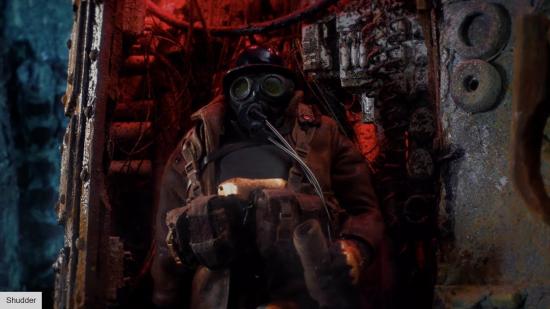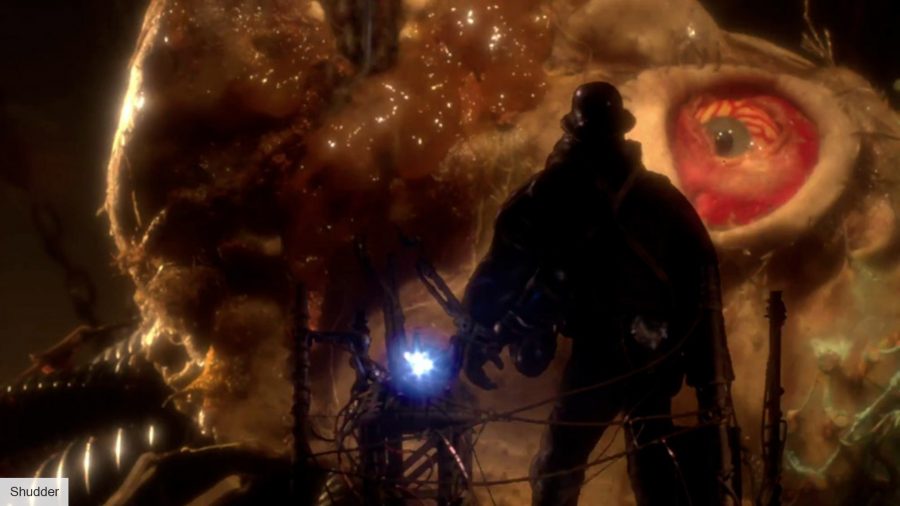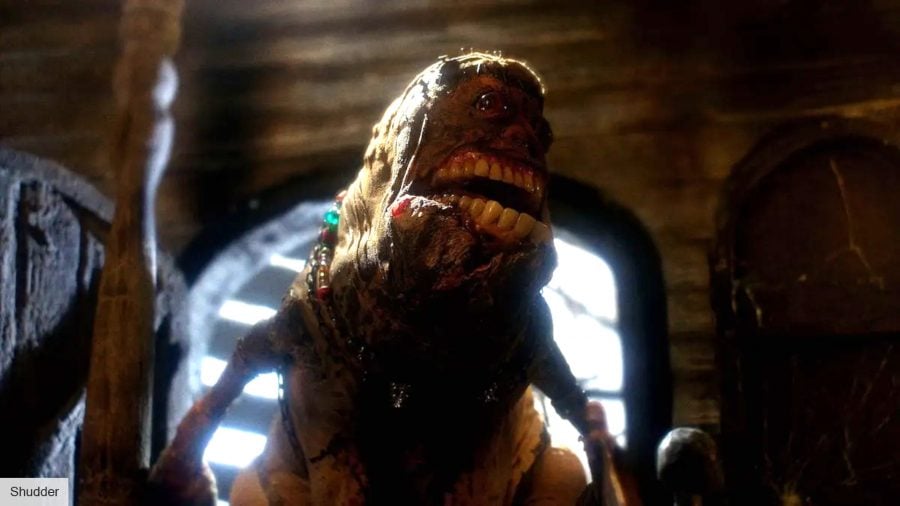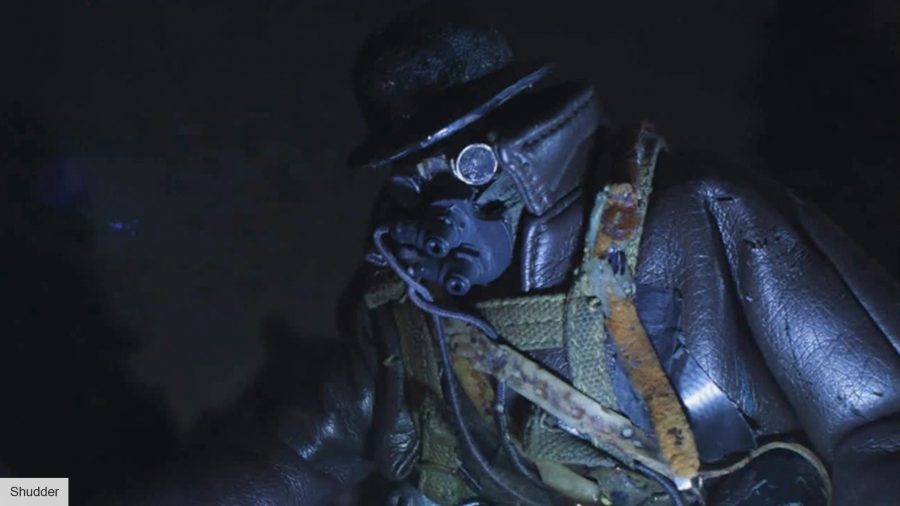After 30 years, Mad God, the bizarre horror movie that’s been a long-time passion project of Phil Tippett, is finally widely available for viewing. Taking the Star Wars and Jurassic Park effects icon three decades to complete, Mad God’s arrival on Shudder marks the end of a long journey for the tenured filmmaker.
A stop-motion odyssey into the depths of a rotting world, Mad God resists simple explanation. The Assassin is the main character, a wordless guide through the debris of Tippet’s dystopia, surrounded on all sides by corporate machines run amok, mind-bending architecture, and creatures that seem to have crawled out from the recesses of your nightmares.
I thought it a masterpiece in my Mad God review, and now that it’s on Shudder, we got the chance to talk to Tippett about the whole process. He tells us why he’s glad to put the animated movie behind him, the inventive processes he used for certain scenes, and why working on Star Wars was such a formative experience for him.
The Digital Fix: I saw Mad God last year during its film festival run. You must be relieved that it’s finally getting out there.
Phil Tippett: Yeah, I was glad to put it behind me, because it really fucked me up. But I never wanted to stop working on it, and had to get kicked off of it, too. Even when we sent the final DCP, to Shudder, the composer, Dan Wool, the sound designer, Richard Beggs, and I still wanted to do some sound and music work, and they wouldn’t let us do it. So, it remains incomplete to me.
The film opens with a religious verse. How did you decide to use that quote in particular?
Well, I used the Torah, because it was a little bit worse than what was in the Bible. It’s a Leviticus quote of a damning, and if you read it, it’s really [about] a psychotic God. [In Mad God] I think it’s the result of the repetition of media that’s turned us into a psychotic culture, particularly in the United States. I mean, that’s really self-evident.
You just follow the zeitgeist of the world that you’re living in, and just do an interpretation of that. It has been called a surrealist film, and in no way is it surrealistic. Surrealism relies on stark juxtapositions, but this has very clear transitions from things to things, there’s no schism, like in surrealism.
Rewatching it now, I was struck again by how much of a tone-piece it is. You’ve compared it narratively to Carl Jung’s The Red Book.
Yes, definitely. I came across that halfway through making Mad God, and that really illuminated to me that many people in the creative process take that same Joseph Campbell, hero’s journey path. It’s just innate within us, and that was really the through-line of Mad God, but it was about a character, and not the character that becomes transformed.
Terror: The best monster movies
Many of the scenes could be their own movie, even though they’re all stitched together. Did you have any idea of how it was going to sit together while you were making it?
Well, that’s an interesting question. In a lot of the interviews, I’m saying, ‘Well, I just worked from the unconscious and I really didn’t know what I was doing and I built it up as I was going along’. But we’re going to have a wrap party at my studio the day it drops on Shudder, and the editor Ken Rogerson and I dug up about three minutes of 35mm footage I shot 30 years ago. So, we cut that in and then we just built it out, only about 10 minutes, with storyboards.
Grim: The best zombie movies
I was really amazed, some of these storyboards went back 30 years, even though it was different, how remarkably similar it was. I guess I didn’t think about it until we saw that. I suspected that there was gold down there, or oil, but I didn’t know. It was actually quite shocking to me how almost identical the storyboards were to what we ultimately achieved.
I’ve read you compare yourself to a choreographer – did you feel like a conventional director on Mad God?
I was more of a choreographer for the theatrical films that I worked on. I thought of myself as a choreographer in terms of the creatures, working in-service to the director. But of course, in performance, there’s a tremendous amount of choreography that goes on, and to that degree, yeah, I was director and choreographer.

Going from Mad God to your previous work in Star Wars, Jurassic Park, and Starship Troopers, scale has been a thematic through-line, with the protagonists dwarfed by huge monsters. Would you agree with that observation?
Scale was something that just emerged, and that became a theme. You never know how big a character is, and Richard Beggs, the sound designer, in the beginning assumed that The Assassin was tall, because he imagined the scale up the character. And I said, ‘Well, just look at it’.
Glorious: The best anime movies
It put him and a number of people in a conundrum, because as you watch it, you have no idea what the scale is. It’s just switched up all the time. That was an important thing to me. Scale, and then process – what happens when an entity is reduced to its constituent elements, and creates a new universe?
You touched on the film not being finished for you earlier. At what point did you feel any given scene was completed?
It was pretty conventional, because you’re working with a team of people, so it would map. I started off over 30 years ago with about 12 pages that weren’t even a synopsis. It was just kind of a tone thing, and then I would storyboard it.
We had a scene, we would put 30 storyboards up and mark them off, lock them down then one at a time. We’d find something and add a storyboard or delete a storyboard as we went along.
Two human characters show up later in the film…
Well, how did you know they were human?
Fair! Human presenting – how did you know you wanted to incorporate on-screen actors for those parts?
It was just part of the vision. I would switch things out as I felt they would complement the film. There are a number of human performers in it, mostly non professional. My friend Alex Cox is in it – there’s a nurse and a surgeon, and then Alex’s character who is called The Last Man.
Then the alchemist character, in the last third of Mad God, there were five different performers doing that. It was whoever I could get with a costume and mask. I direct people like I direct puppets; ‘Do it like this’, and they do their version of that.
SPACE! The best science fiction movies
How did the relationship with Shudder come about? Were there conversations while Mad God was screening at festivals?
One of the heads of my studio, Gary Mandel, is from Canada, and he had contacts in Canada, with Colin Geddis and his team, his wife, Kat, and Josh Sobel. They were really the spearhead of the whole venture of marketing the thing, which I knew absolutely nothing about. I’m more than happy to put myself in the hands of people that know more than I do. I just let them go.
As a director, I don’t micromanage things at all, which seems incongruous with being specific in terms of performance. When we were doing the operating scene, it begins with a boom down into this hospital, which I shot 30 years ago, so we matched that set. I was just going to shoot it like live action, and the director of photography, Chris Morley, and I set the thing up, and it just looked terrible.

It took about three weeks to come up with the process that I kind of stole from some Japanese horror films. I would have the non-professional actors say, for a shot, repeat the same action until it became part of their muscle memory. Then, when shooting, I wanted them to know their movements, but I also wanted to put it in another world. So I broke it by having them do the performance backwards, as slow as they possibly could.
Wild: The best adventure movies
We just kept the cameras running, and then we reversed that. So they’re going forward, and we compress the time. So it was roughly around 24 frames a second, and that was it, it just took time to figure out that choreography.
Your work on Star Wars is incredible. What was it like being part of the Original Trilogy?
It was really a dream come true. We always had the ambition to work on Ray Harryhausen movies, and then George came along. It was great to be included in the first Star Wars, because it was the first feature that most of us had really worked on, we’d done commercials for years before. It was just a lot of fun. George was a really great creative manager, like ‘Wow, this is really great, this is a really fun movie’.
Quest for peace: The best sci-fi series
We’d seen the scenes that we were working on, the Cantina and the chess scene, but it wasn’t until the cast and crew screening that we really realised what George had made. Only George knew what he made, similar to me and Mad God.
George was a mentor in that sense, because nobody had any idea what to do other than George. And for him, it was fortuitous; time was on my side, and I had a crew of people that knew me very well, so we did a Vulcan mind meld, and it wasn’t that difficult.
But when we went to the cast and crew screening, I was just like, ‘Holy shit’. I don’t know how many times I saw it, I couldn’t believe it. Then we were pretty certain it would lead to something else, which it did with The Empire Strikes Back and then Return of the Jedi? By the end of Jedi, we’d all had enough. I really wanted to move on. But it was the experience of a lifetime.
Netflix has a new Henry Selick film coming out, and Mad God’s now on Shudder. Do you think streaming services are helping to bring stop-motion animation back to the forefront?
Oh, definitely. There seems to be a really terrific resurgence. Stop-motion movies have not done that well theatrically. But with streaming it’s so much easier to get hold of the material in your own home at any time you want, for a nominal fee. It’s a really great way of getting things out there.
Although, we all make these things for theatrical distribution, so it’s not the greatest way to see it, but it’s a way to see it. I mean, there’s an aspect of Mad God that you can get on your phone, because once you get into it, it’s a mind fuck. As long as it exists in your solipsistic mind, then it’s there. Once you have a dream, you have the training.
Mad God is on Shudder now.



